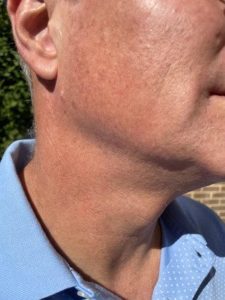People with a basal cell skin cancer have a 44% risk of another basal cell skin cancer in the next three years
What does skin cancer look like?
Red spots and tan spots on the skin – how much sun exposure have you had?
A look in the mirror this time of year can be a window into what you did this summer. If red spots, rough patches, freckles, tiny blood vessels, or a little sore that forms a scab are staring back at you in the mirror, it’s time for you to start thinking about ways you can protect your skin from skin cancer.
The freckles and tan spots can be a kind of connect-the-dots game of where you were this summer- the beach, the pool – or is the freckle at the tip of your nose a left over from that long hike where your nose peeled because you forgot to reapply sunscreen?
If your look in the mirror sends you to your smartphone googling “skin cancer red spot,’” it’s time to see your dermatologist and start learning what you can do to lower your risk of skin cancer.
How do you get skin cancer, and how can you prevent it?
Who gets skin cancer, and when, depends on a few things– some of which are within your control, but unfortunately some risk factors may not be in your control.
For example, check one box off for a higher risk of skin cancer if you have fair skin, light eyes, and red hair.
But you have the option of not having to check off a few more boxes.
First, avoid extensive amounts of unprotected sun exposure. And please don’t go into a tanning bed- that seriously adds to your risk of skin cancer. According to the American Academy of Dermatology, just one indoor tanning session increases the risk of some forms of skin cancer by as much as 70%.
Skin cancer forms when your skin cells become damaged, usually from ultraviolet B light. The mutations that the sun causes eventually build up and can transform a normal skin cell into a skin cell in overdrive. This kind of uncontrolled and nonstop growth is what ends up being diagnosed as skin cancer by your dermatologist.
The most common types of skin cancer
Typically, basal cell carcinoma, the most common type of skin cancer, happens after intermittent, but intense sun exposure. Even just a few bad sunburns can be to blame.
But squamous cell carcinoma, the second most common type of skin cancer and the type that can be a little more dangerous than basal cell carcinoma, is linked to your cumulative, or long term, sun exposure. The long years and summers add up.
For some, inherited genetic mutations cause skin cancer. If you get basal cell skin cancer before the age of 20, you should talk to your dermatologist about the possibility of an inherited genetic syndrome that makes you susceptible to skin cancer. Your dermatologist can help listen to your family and personal history and help you figure out if you fall into this category.
And the good news is that not all skin cancers are created equally.
High, medium and low risk skin cancers
Dermatologists that specialize in skin cancer and Mohs surgeons, dermatologic surgeons that treat skin cancer, have developed algorithms to help categorize skin cancers into high, medium, and low risk.
Generally speaking, lower risk skin cancers grow on the trunk, arms, and legs. Medium risk skin cancers are on parts of the outer cheeks, forehead, scalp, neck, and shin. Higher risk skin cancers are skin cancers on the face, specifically the central face, skin cancers on the ear, skin cancers around the eyes, and also skin cancers on the hands and feet.
If you have had a basal cell carcinoma, it’s time to make some changes to lower your risk of skin cancer because you have a 44% risk of developing another basal cell skin cancer in the next 3 years. But even so, doing your part to control what you can- like wearing sunscreen and avoiding getting sunburns- is a good way to avoid adding additional risk of getting repeat skin cancers.
One easier-said-than-done approach is to have a goal of having your skin look the same all year when you look in the mirror- try not to end up with too many freckles or red spots at the end of summer. That less sun-damaged face you see in February should ideally be looking back at you in September. And it can be, with good sunscreen use.



